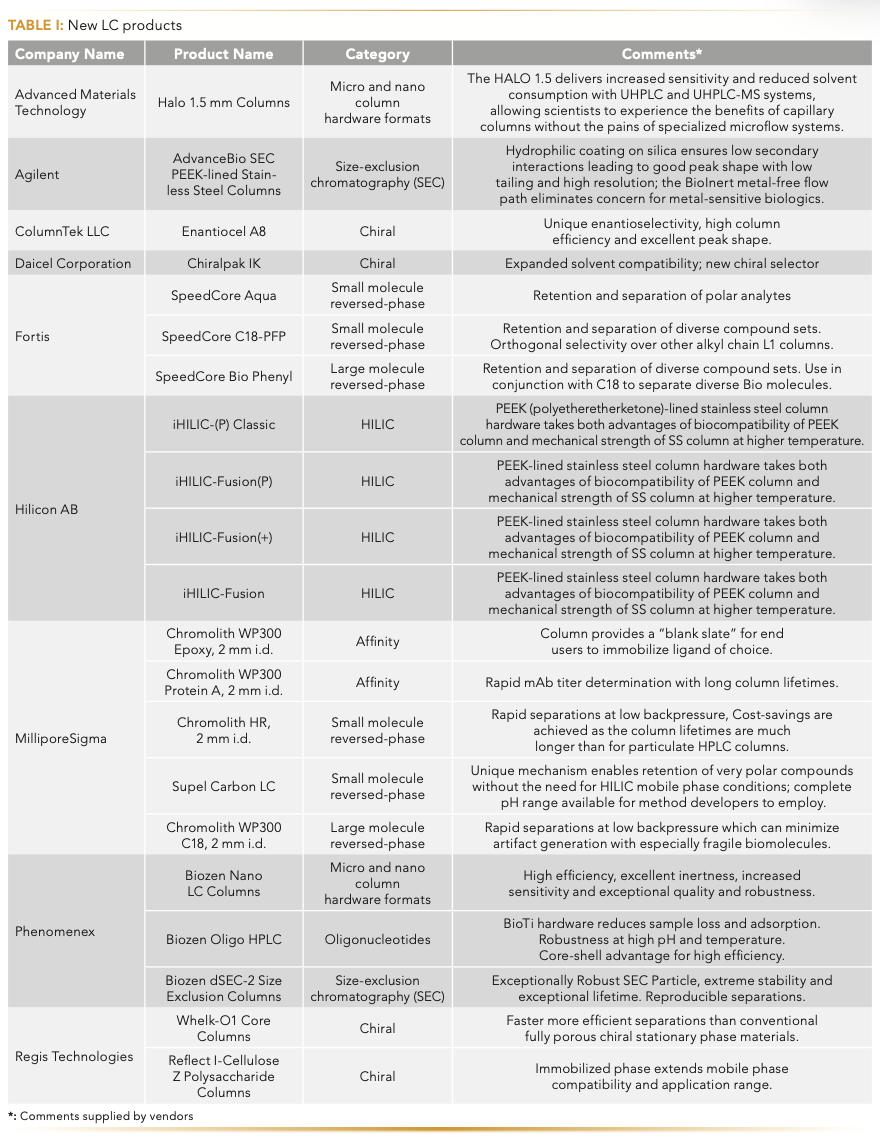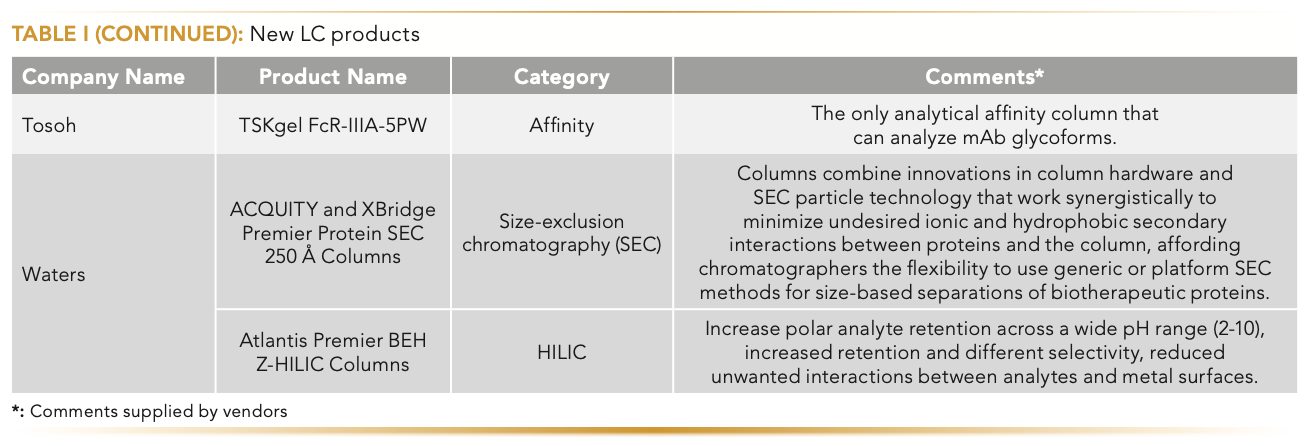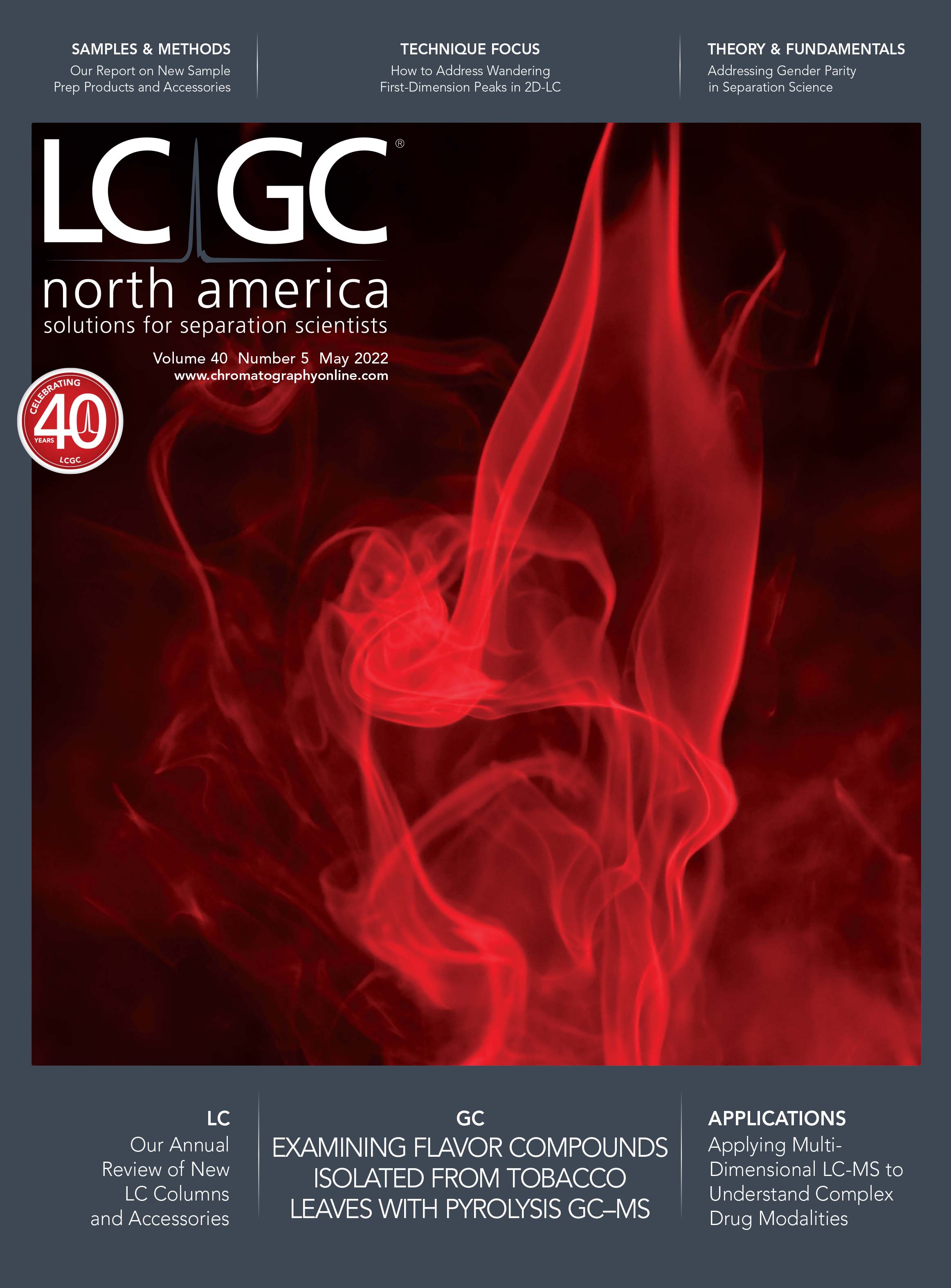New Liquid Chromatography Columns and Accessories in 2022
This article covers liquid chromatography (LC) columns and accessories commercially released after Pittcon 2021 through this year’s virtual conference. Like in the past, LCGC sent out a survey in late 2021 and early 2022 asking vendors to supply information on products launched over the past year. Note that new products for gas chromatography (GC), LC instrumentation and software, and sample preparation are covered elsewhere. The information for this article was obtained over several months; therefore, it is possible that some information was missed or misinterpreted. The reader is encouraged to check with specific vendor sites for additional products as well as more detailed information on product usage and attributes. Links to vendor sites are provided where applicable.
The vendors that responded to the survey and their new liquid chromatography (LC) products are listed in Table I. The products vary in targeted analyte type as well as in mode of chromatographic operation. The columns were initially categorized as addressing small molecule or large molecule separations. Within these categories, the products were further separated based on the mode of separation, including reversed-phase LC (RPLC), hydrophilic-interaction LC (HILIC), chiral, size-exclusion chromatography (SEC), and affinity chromatography. Two additional subcategories extracted this year are treated as separate entities—new nano- and micro-column format offerings and columns targeting oligonucleotides are also discussed.


The products launched over the past year revealed that there was an emphasis in the industry to reduce or eliminate analyte–metal interactions. Most of the categories this year include some type of advance in metal passivation or new uses of established “non-metal contact” hardware, such as PEEK (polyetheretherketone)-lined stainless steel. Unlike in previous years where there were enough new products in given categories to generate illustrative sub-tables, the new products introduced this year are spread evenly across the categories, leaving only a few in any given section.
Small Molecule
Reversed-Phase
Selectivity and retention alternatives for small molecule separations continues to be a market need. Fortis introduced two new surface chemistries on their 2.6- and 5-μm superficially porous particles (SPP) platforms. The SpeedCore C18-PFP is a C18 and pentafluorophenyl combination phase that continues a recent trend of “enhanced C18 chemistries” intended to improve the resolution of diverse compound sets and provide alternate selectivity when compared to the traditional alkyl chain stationary phases. The second phase introduced by the company in this category is the SpeedCore Aqua phase. This stationary phase is described as a proprietary polar-endcapped phase intended for polar analytes not suited to hydrophobic C18 columns. More information on these columns may be obtained on Fortis’s website (https://fortis-technologies.com/core-shell-physicals/).
MilliporeSigma introduced a new monolithic column for small molecule analysis. The Chromolith HR 2 mm i.d. C18 column features a macropore (through-pore) size of 1.15 μm and a mesopore (internal pore) size of 150 Å. The column provides rapid separations at low backpressure and cost-savings because of its longer column lifetimes as the unique macropore size prevents column fouling because of matrix contaminants. The company also claims that a high plate count, which rivals sub-2 μm ultrahigh performance LC (UHPLC) columns, can be achieved. For additional information, the reader is directed to the following website: https://www.sigmaaldrich.com/US/en/technical-documents/technical-article/analytical-chemistry/small-molecule-hplc/chromolith-hplc-and-uhplc-columns.
MilliporeSigma also recently introduced a new porous graphitic carbon (PGC) phase, Supel Carbon, as an alternative column choice for polar compound analysis via RPLC. The company notes that a unique mechanism enables retention of polar compounds without the need for HILIC mobile phase conditions. In addition, the complete pH range is available for method developers to employ. The company states that the patent-pending synthetic procedure enables columns to operate up to 12,000 psi, which was never possible with prior generation carbon particle-packed columns. More information is available at https://www.sigmaaldrich.com/US/en/technical-documents/technical-article/analytical-chemistry/small-molecule-hplc/supel-carbon-lc-hplc-columns.
HILIC
The introduction of HILIC phases has decreased over the past several years. However, with the attention focused on metal elimination and passivation, it is not surprising to witness a bit of a resurgence in this category. The small, polar molecules most often analyzed in HILIC are notorious for interactions with metal surfaces that can result in poor peak shapes and also low recovery.
Hilicon introduced a number of their HILIC phases in PEEK-lined stainless steel to eliminate or limit nonspecific binding of analytes with metal surfaces. The iHILIC-Fusion(P) is described as a modulated amide with phosphate and quaternary ammonium moieties built on a polymeric support. The iHILIC-(P) Classic is a modulated diol HILIC column with sulfate and quaternary ammonium attachments. This phase is also based on a polymer substrate. The iHILIC-Fusion and iHILIC-Fusion(+) are silica-based HILIC stationary phases that are described as modulated hydroxyethyl amide columns. The former contains the quaternary ammonium moiety as well as both sulfate and phosphate groups, whereas the latter contains only the quaternary ammonium and sulfate groups. All of the columns are said to provide retention and selectivity for a wide range of polar analytes. More information is available at https://www.hilicon.com/ihilic/.
Waters developed Atlantis Premier ethylene bridged hybrid (BEH) Z-HILIC Columns for HILIC separations. The sulfobetaine zwitterionic bonded phase chemistry, built on 1.7 μm, 2.5 μm, and 5 μm BEH particles, provides a wide range of polar analyte retention at an extended pH range, according to the company. The new offering in this chemistry utilizes Waters metal passiviation technology, which significantly reduces unwanted interactions between analytes and metal surfaces in the column hardware. The result is improved peak shape and increased sensitivity for and untargeted metabolites as well as other target analytes, such as aminoglycosides, nucleosides, nucleotides, and nucleobases, among others. See the Waters website (https://www.waters.com/nextgen/global/products/columns/atlantis-premier-columns.html) for further details.
Chiral
New offerings in chiral separations continue the recent trend of expanding on polysaccharide-based supports and taking advantage of SPP technology.
ColumnTek LLC introduced the Enantiocel A8, which is described as an amylose tris(3-chlorophenyl carbamate)-coated phase that is available on both 5- and 3-μm fully-porous particles. The new phase is noted as providing unique enantioselectivity, high column efficiency, and excellent peak shape. According to the company, the coated amylose tris(3-chlorophenylcarbamate) selector can provide better enantioselectivity than the corresponding immobilized version. Further details can be obtained by emailing info@columntek.com.
Daicel Corporation introduced Chiralpak IK immobilized cellulose tris(3-chloro-5-methylphenylcarbamate) in both 5- and 3-μm formats. Immobilization is stated by the organization to expand solvent compatibility. The new chiral selector is a cellulosic version of Chiralpak IG. A media release statement and further information can be accessed at https://chiraltech.com/daicel-chiral-technologies-announces-the-launch-of-chiralpak-ik/.
Regis Technologies, Inc, launched Reflect I-Cellulose Z Polysaccharide columns for chiral analysis in normal phase, RP, and supercritical fluid chromatography (SFC). The phase is based on cellulose tris(3-chloro-4-methylphenylcarbamate).
The phase is reported to extend the range of selectivity available in the line of Reflect Polysaccharide-based chiral stationary phases (CSPs). More on this line of chiral columns may be viewed at https://www.registech.com/reflect-polysaccharide-phases/.
Regis Technologies also introduced Whelk-O1 Core columns to the market. Built on superficially porous particles (SPPs), the columns are reported to provide faster, more efficient separations than conventional 5- or 3-μm fully porous chiral stationary phase materials. One advantage of the synthetic CSP is that it is available in two different absolute configurations: R,R and S,S, which can be important when peak elution order matters. Applications and other supporting information can be found at https://www.registech.com/whelk-o1/.
Large Molecule Selectivity and Performance
Reversed-Phase
Fortis launched a new product intended for the reversed-phase separations of large molecules. The SpeedCore Bio Phenyl column is available as a 2.6- or 5-μm, 300 Å Wide Pore Bio phenyl phase that has been optimized for peptide and protein separations. The column can be used in conjunction with Bio C18 to run complex protein and tryptic digests, according to the manufacturer. For additional information, see https://fortis-technologies.com/core-shell-physicals/.
MilliporeSigma released a wide-pore monolithic column, called Chromolith WP300 C18, in 2 mm i.d. hardware. The macropore structure of 2 μm and mesopores of 300 Å allows rapid separations at low backpressure, which can minimize artifact generation with fragile biomolecules. The company notes that for biomolecule analysis, the unique macropore size prevents column fouling because of matrix contaminants. The company also notes that the high plate count provided by the new monoliths rivals sub-2.0 μm UHPLC columns. More information can be found at https://www.sigmaaldrich.com/US/en/technical-documents/technical-article/analytical-chemistry/large-molecule-hplc/chromolith-widepore-300-hplc-columns.
Size-Exclusion Chromatography (SEC)
SEC resolves analytes based on molecular size and is often used as a complementary technique to RP analyses of proteins. Columns utilized in SEC are often characterized by their strict control of pore size and by their inert surface chemistry. Because inertness also includes the column hardware, it is not surprising that the new products in this category include different approaches toward metal passivation.
AdvanceBio SEC PEEK-lined stainless-steel columns from Agilent Technologies provide aggregate analysis of metal-sensitive biologics owing to the use of their BioInert metal-free flow path, which is reported to eliminate the concern for metal-sensitive biologics.
The columns come with 1.9 μm particles with both 120 Å and 200 Å pores. As stated by the company, a hydrophilic coating on silica ensures minimal secondary interactions leading to good peak shape with low peak tailing and high resolution. For a more detailed description of the Agilent offering, see https://www.agilent.com/cs/library/brochures/brochure-bioInert-columns-5994-2983en-agilent.pdf.
Phenomenex introduced Biozen dSEC-2 SEC columns to the market. The Biozen dSEC columns are packed with low pore volume silica with a proprietary hydrophilic diol-type bonded surface chemistry. The silica provides mechanical strength to improve column packing. The stationary phase modification prevents the silica surface from interacting with the protein samples. The company claims column stability exceeding 100 hr even with harsh mobile phase and high flow-rates. More information can be found at https://www.phenomenex.com/products/detail/biozen/dSEC-2.
Waters recently commercialized Acquity and XBridge Premier Protein SEC 250 Å Columns. The columns are said to provide an accurate determination of protein aggregates, monomers, and small-sized fragments in proteins that range in size from 10,000 to 650,000 daltons. The columns are intended for the characterization and monitoring of biotherapeutic product size variants. The Acquity column utilizes Waters hybrid (BEH) particle technology in a 1.7 μm particle size, whereas the XBridge sports a 2.5 μm particle bed. In both cases, the BEH particles are modified with hydroxy-terminated polyethylene oxide (PEO) and utilize Waters metal passivation technology. The columns are reported to combine innovations in column hardware and SEC particle technology that work synergistically to minimize undesired ionic and hydrophobic secondary interactions between proteins and the column. Further details and offerings can be found at www.waters.com/sec.
Affinity
Affinity chromatography is a separation technique based on highly specific interactions between two partners. Through the immobilization of one partner to a solid surface, the other partner can be effectively “fished” out of a complex mixture with high specificity. Affinity chromatography is yet another complementary tool employed to fully characterize large molecules.
MilliporeSigma introduced the Chromolith WP300 Epoxy 2 mm i.d. column that can be customized by the user to immobilize their own ligand to the column. The wide pore monolithic structure is often used as a “blank slate” for affinity chromatography work, but has also been used as a starting point for HILIC, chiral, and ion-exchange (IEX) applications. MilliporeSigma also released a specific affinity column, Chromolith WP300 Protein A, for rapid monoclonal antibody (mAb) titer determination. The monolithic structure provides long column lifetimes and consistent binding efficiencies of mAbs even at high flow rates, according to the company. For further information on wide-pore monolith offerings, see https://www.sigmaaldrich.com/US/en/technical-documents/technical-article/analytical-chemistry/large-molecule-hplc/chromolith-widepore-300- hplc-columns.
Tosoh launched the TSKgel FcR-IIIA-5PW, a 1000 Å polymethacrylate surface treated with modified recombinant FcyRIIIA intended for antibody drug analysis. The company claims that this is the only analytical affinity column that can analyze mAb glycoforms. For more information on this HPLC and MS-compatible column, see https://www.separations.us.tosohbioscience.com/HPLC_Columns/id-8778/TSKgel_FcR-IIIA-5PW.
Micro and Nano Column Hardware Formats
Advanced Materials Technologies introduced a number of their Halo columns in a new 1.5 mm i.d. format. Four new product offerings, including a 90 Å C18, 160 Å ES-C18, and two 1000 Å phases (C4 and diphenyl) in column lengths of 50–150 mm, are now available. According to the company, the 1.5 mm i.d. delivers increased sensitivity and reduced solvent consumption, allowing scientists to experience the benefits of capillary columns without the pains of specialized fittings and techniques as it feels and installs like an analytical 2.1 mm i.d. column. Separations utilizing the 1.5 mm format consume half the solvent compared to 2.1 mm columns. In addition, twice the signal intensities in comparison to 2.1 mm columns are reported. A number of applications, as well as a brochure, are available at https://halocolumns.com/introducing-the-new-halo-1-5/.
Phenomenex introduced Biozen Nano LC Columns (https://www.phenomenex.com/info/page/21resourcesnano). According to the developers, the 75 μm i.d. columns utilize core-shell particles with a highly consistent morphology. The format minimizes band broadening associated with diffusion and mass transfer, leading to higher efficiency. The company also claims minimal peak widths, which enhances the separation for omics analysis. The columns also feature a SecurityLink finger-tight fitting system that simplifies the connection process and provides consistent performance with technology that prevents column damage because of overtightening. Stationary phases that are available in this format include Biozen Peptide PS-C18 (charged surface ligand/C18 ligand), Biozen Peptide XB-C18 (di-isobutyl C18), and Biozen Polar C18 (“enhanced selectivity” C18). Each of the stationary phases is available in 150- and 250-mm columns lengths.
Oligonucleotides
Like polar molecules and proteins, oligonucleotides are also notorious for binding to metals. Phenomenex commercialized bioZen Oligo columns that utilize organo-silica core-shell particles with a highly consistent morphology that minimizes band broadening associated with diffusion and mass transfer. According to the company, this leads to higher efficiency and minimal peak widths, which is critical for the separation of closely eluting impurities associated to synthetic oligonucleotides. The columns are constructed with BioTi hardware which reduces sample loss because of metal adsorption and core-shell particles which provide for high efficiency. The company also claims robustness at high pH and temperature. For further information, see https://www.phenomenex.com/Products/detail/biozen.
Conclusions
From small polar molecules to proteins and oligonucleotides, different approaches to minimizing undesired metal interactions are being applied. Although the new chromatography column products launched in 2021 and early 2022 were evenly spread across many categories, they did have one common theme—metal passivation. There was some type of metal passivation or elimination that was apparent in each of the categories except “Chiral.” Whether metal-free chromatography is enacted via PEEK or PEEK- lined stainless-steel hardware, selected metal alloys, or passivated stainless-steel approaches, it will be interesting to see if the trend continues.
Acknowledgments
The author would like to acknowledge and thank Brian J. Murphy and Michael Dong for their review the draft manuscript and valuable feedback.
ABOUT THE AUTHOR
David S. Bell is a Research Fellow in Research and Development at Restek. He also serves on the Editorial Advisory Board for LCGC and is the Editor for “Column Watch.” Over the past 20 years, he has worked directly in the chromatography industry, focusing his efforts on the design, development, and application of chromatographic stationary phases to advance gas chromatography, liquid chromatography, and related hyphenated techniques. His main objectives have been to create and promote novel separation technologies and to conduct research on molecular interactions that contribute to retention and selectivity in an array of chromatographic processes. His research results have been presented in symposia worldwide, and have resulted in numerous peer-reviewed journal and trade magazine articles. Direct correspondence to: LCGCedit@mmhgroup.com


New Study Reviews Chromatography Methods for Flavonoid Analysis
April 21st 2025Flavonoids are widely used metabolites that carry out various functions in different industries, such as food and cosmetics. Detecting, separating, and quantifying them in fruit species can be a complicated process.













